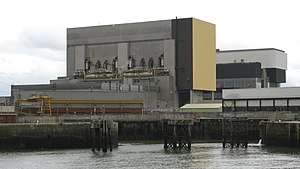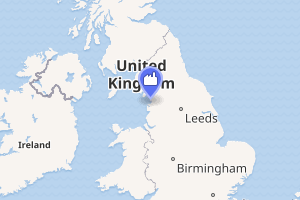Heysham nuclear power station
Heysham Power Station is a nuclear power station in Heysham, Lancashire, England, operated by EDF Energy. The site is divided into two separately-managed stations, Heysham 1 and Heysham 2, both with two reactors of the advanced gas-cooled reactor (AGR) type.
| Heysham nuclear power station | |
|---|---|
 Heysham 1 & 2 | |

Location in Lancashire##Location in the City of Lancaster district | |
| Country | England |
| Location | Heysham, Lancashire |
| Coordinates | 54°1′44″N 2°54′58″W |
| Status | Operational |
| Commission date | 1989 |
| Operator(s) | EDF Energy |
| Nuclear power station | |
| Reactors | 4 |
| Reactor type | AGR |
| Thermal power station | |
| Primary fuel | Uranium dioxide |
| Power generation | |
| Nameplate capacity | (1150+1250) MW |
| External links | |
| Commons | Related media on Commons |
grid reference SD4000459632 | |
In 2010, the British government announced that Heysham was one of the eight sites it considered suitable for future nuclear power stations.[1]
On 1 August 2016, Heysham 2's Unit 8 broke the world record for longest continuous operation of a nuclear generator without a shutdown. This record-breaking run exceeds the previous record of 894 days set by Pickering Nuclear Generating Station's Unit 7 (Lake Ontario, Canada) in 1994.[2] The reactor has generated 13.5 TWh of electricity so far during this continuous operation, taking its lifetime generation to 115.46 TWh.
Heysham 1
Construction of Heysham 1, which was undertaken by British Nuclear Design & Construction (BNDC), a consortium backed by English Electric, Babcock & Wilcox and Taylor Woodrow Construction,[3] began in 1970, with the first reactor commencing operations in 1983 and the second reactor following in 1984. However, initial production levels were low, and full commercial operation was only declared in 1989. It is likely to remain in operation until 2024. Its generating capacity is 1150 MWe. The reactors were supplied by National Nuclear Corporation and the turbines by GEC.[4] There were 4 × 17.5 MW auxiliary gas turbines on the site, these had been first commissioned in January 1977.[5]
Heysham 1 shares its reactor design with Hartlepool nuclear power station, which introduced the replaceable pod boiler design. The CEGB specified a compact design for the Heysham 1 and Hartlepool power station reactor islands in comparison to the design of the two preceding stations at Hinkley Point B and Hunterston B in order to reduce the capital cost, but this caused expensive construction delays because of restricted access. The Heysham 2 reactor island occupies a much larger footprint than Heysham 1 for a similar design output of power.
In 2013 a defect was found by a regular inspection in one of the eight pod boilers of unit 1. The reactor resumed operation at a lower output level with the defective pod boiler disabled, until June 2014 when more detailed inspections confirmed a crack in the boiler spine. As a precaution, unit 2 and the sister Hartlepool nuclear power station were also shut down for inspection.[6][7]
All units have since returned to full power after successful inspections on the three other reactors revealed no other defects. Heysham 1 unit 1 will operate on 7 out of the 8 boiler pods until a detailed repair strategy has been developed.
Heysham 2
The construction, which was undertaken by a consortium known as National Nuclear Corporation (NNC),[3] began in 1979 and the station opened in 1988. Its generating capacity is 1250 MWe, and it is estimated to keep running until at least 2030. Heysham 2 shares its reactor design with Torness nuclear power station and is a development of the reactor design used at Hinkley Point B. The reactors were supplied by NNC, the turbines and boilers by NEI.[4]
On 15 August 2019, Reactor 8 inside Heysham 2 let off a large amount of steam, with banging noises at approximately 11pm that could be heard 7 miles away in Lancaster. This caused alarm among local residents, and numerous calls to the police reporting “gunshots”. EDF later reported that a reactor had earlier experienced a "non-planned shutdown after an electrical fault", and the noise was from the re-start process.[8][9]
See also
- Nuclear power in the United Kingdom
- Energy policy of the United Kingdom
- Energy use and conservation in the United Kingdom
References
- "Nuclear power: Eight sites identified for future plants". BBC News. BBC. 18 October 2010. Retrieved 18 October 2010.
- British reactor takes record for longest continuous operation, World Nuclear News, August 2, 2016.
- The UK Magnox and AGR Power Station Projects
- "Nuclear Power Plants in the UK". Archived from the original on 2009-07-19. Retrieved 2009-04-11.
- Handbook of Electricity Supply Statistics 1989. London: The Electricity Council. 1990. p. 8. ISBN 085188122X.
- "EDF Energy shuts Heysham A1&2 and Hartlepool for pod boiler inspections". Nuclear Engineering International. 11 August 2014. Retrieved 14 August 2014.
- "UK regulator backs EDF Energy on reactor checks". World Nuclear News. 13 August 2014. Retrieved 14 August 2014.
- Calderbank, Matthew (16 August 2019). "Loud bangs cause alarm in Heysham, Morecambe and Lancaster after 'incident' at nuclear power station". Lancashire Post. Retrieved 17 August 2019.
- "A statement on noise from Heysham 2 power station". EDF Energy. 17 August 2019. Retrieved 17 August 2019.
External links
| Wikimedia Commons has media related to Heysham nuclear power station. |
- Heysham 1 official website
- Heysham 2 official website
- Heysham 1, Nuclear Engineering International wall chart, 1971
- Heysham 2/Torness, Nuclear Engineering International wall chart, 1981


.jpg)